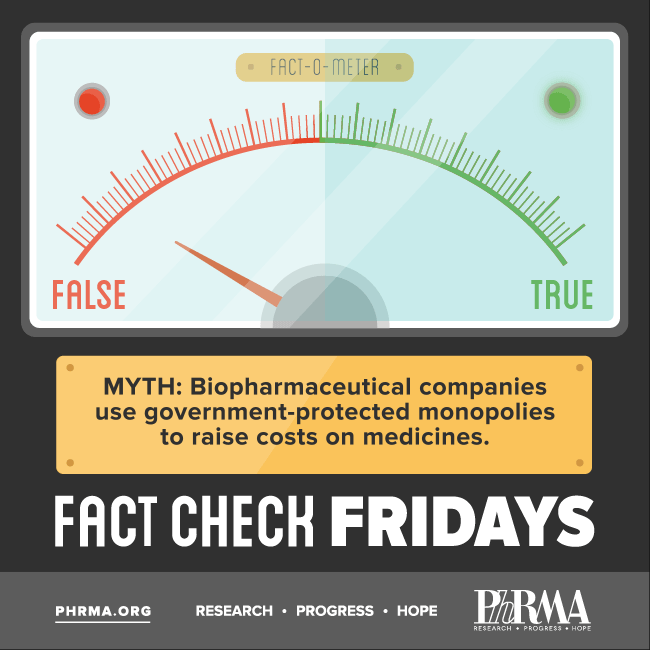Fact Check Friday: The truth about biopharmaceutical patents
A Fact Check Friday on the realities of innovation, IP and patents.

Fact Check Friday: The truth about biopharmaceutical patents.
A Fact Check Friday on the realities of innovation, IP and patents.

Fact Check Friday: The truth about biopharmaceutical patents.
MYTH: Biopharmaceutical companies use government-protected monopolies to raise costs on medicines.
FACT: Patent-protected medicines routinely face competition from other brand name medicines, which helps drive down costs while patent protection and intellectual property rights allow the biopharmaceutical industry to develop life-saving medicines and cures.

Recent reports and news stories have alleged that government-protected monopolies have led to high drug prices for patients. The studies distort the proven IP system as monopolistic and ignore the very real challenges and obstacles that are inherent in the R&D process.
First, the biopharmaceutical industry is is one of the most competitive industries in the country with hundreds of companies striving to create new technologies and spur ground-breaking discoveries. What’s more, the law provides limited exclusivity that encourages the development of new technologies, especially medicines. This also ensures that free riders cannot steal this technology during this limited time.
Competition is the essence of the biopharmaceutical sector – not monopoly. Even discounting generics for a moment, brand drugs face vigorous competition long before generics arrive on the market. Tufts University researchers have found that the average length of time before a first-in-class drug got its first direct competitor has dropped from 10.2 years in the 1970s to 1.2 years for the period 1990-2003. What’s more, the competitive marketplace in the U.S. has enabled significant cost reductions. For example, Express Scripts recently stated “Hepatitis C is the first example where price is lower in the U.S. vs. Western Europe because of our negotiations.”
Intellectual property (IP) rights, including patents, are fundamental to the creation of the drugs and cures that extend and improve lives. In this way, the role of patent protection in the biopharmaceutical industry differs greatly from other industries. There’s a big difference between creating the medicines of tomorrow and making widgets.
It’s key to understand that unlike patents in other industries, biopharmaceutical patents cover products that take a very long time to develop. It typically takes 10-15 years to develop a new medicine from the earliest stages of discovery through FDA approval; thus significant portions of the patent term for new drugs are lost before they even enter the market.
The creation of a new drug is not just building a better mousetrap. In order for America’s biopharmaceutical companies to conduct the critical R&D needed to bring new medicines to patients, the industry spends more on R&D than any other industry in the U.S. economy, and more than the entire National Institutes of Health operating budget, with biopharmaceutical companies investing $58.8 billion in 2015 and over half a trillion dollars since 2000. The average cost to develop a new medicine has been estimated at upwards of $2.6 billion, including the cost of failures, according to the Tufts Center for the Study of Drug Development. And, the Battelle Technology Partnership Practice has found that biopharmaceutical patents require at least twice as much R&D spending per patent than patents in other research-intensive advanced manufacturing industries, including semiconductors, automotives, and aerospace.
Finally, no matter the effort, time and money invested in a new product – nothing is for certain. The innovation process is incredibly difficult, with the odds almost overwhelmingly against actually bringing a new medicine to patients. Most compounds never reach the clinical trial phase and of those that do, less than 12 percent are approved by the FDA. Of those that actually reach the market, only one in five ever recoup the average costs of development.
Despite the significant challenges and uncertainties associate with R&D, biopharmaceutical scientists and researchers are tirelessly working every day to unearth new tools, compounds, and approaches that will ultimately lead to future discoveries that change and save peoples’ lives. They are able to do so because of America’s proven IP system and strong industry competition that pushes each of them to tackle new obstacles and break new ground.